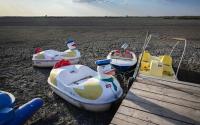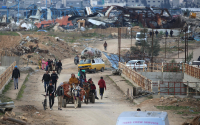23 May 2006Neve Gordon
The crowded room felt like a sauna, a natural effect of the scorching sun hitting the tin roof and the lack of a fan or air conditioner to ease the desert heat. Everyone was talking about the "Wine Route," the Israeli government's plan for a series of farms and wineries designed to draw tourists to the Negev, and the latest insult to its marginalized Bedouin population.
"It is high time to strategize," one person said. "There is no way to oppose it," another responded. This heated discussion went on for several minutes until people began settling down on the mats and pillows adorning the concrete floor.
The meeting's organizer, a coordinator from the Negev Coexistence Forum for Civil Equality, asked our hosts to speak. One after another, the Bedouin men stood up to relate their personal stories. They all told of the state-sanctioned abuse carried out against their community. Injustice followed injustice to produce a merciless tale of expulsion, violence, repression and deception.
Ali Abu Sheita recounted how his parents had been torn from their tribal land and transferred to a barren region where for years they had had to walk fifteen kilometers with their camels and donkeys just to bring water to the village. Yet in the Jewish village nearby, Abu Sheita continued, pipes delivered water directly to every sink. Halil al-Aseiby pointed to the high-voltage electric poles just outside the shack, emphasizing the regulation that forbids "unrecognized Bedouins" from connecting their homes to the power grid. "Even people who need to keep life-saving medicine refrigerated do not receive an exception," he said. Another man suddenly waved a demolition order that was pasted on his "illegal" shack on April 25. "Any day now," he said, "the bulldozers might arrive."
These Bedouins are Israeli citizens just as I am; their only crime is that they are not Jewish.
Bedouins are the indigenous people of Israel's arid Negev Desert. Before the establishment of the State of Israel, approximately 60,000 Bedouins lived in the area, but following the 1948 war only 11,000 or so remained; the rest fled or were expelled to Jordan and Egypt. Under the directives of Israel's first prime minister, David Ben-Gurion, those who remained in Israel were uprooted from the lands they had inhabited and were concentrated in the northeastern part of the Negev, a mostly barren area known as the "enclosure zone," while the more fertile western part of the Negev was reserved for Jewish settlement.
Throughout the 1950s and until the mid-1960s, a considerable portion of their ancestral lands was confiscated and registered as state land. In the 1970s about half of the Bedouin population was moved once again by the Israeli government, this time into seven townships. The idea was to concentrate the Bedouin population within a small area that makes up only a very small percentage of their original tribal lands, the land from which they had been expelled. These Bedouins had to give up all claims to their ancestral land in order to be granted the dubious privilege of living in these overcrowded townships.
The remaining half of the Bedouin population, which today totals about 75,000 people, were unwilling to give up their property rights and are now scattered across the Negev in forty-five villages that have never been recognized by the state.
I visited one of these villages recently with the Negev Coexistence Forum. No more than twenty-five minutes from my small but nice air-conditioned apartment are a series of Bedouin shantytowns. None of the homes in these unrecognized villages are connected to electricity grids, running water, a sewer network or telephone lines. There are no paved roads leading to the villages, and as a result, emergency services cannot reach them quickly, while access to other basic services--health, education and welfare--is difficult and limited.
These Bedouins are currently represented by the unrecognized regional council of the unrecognized villages (since the villages have not been recognized by the Israeli government, the Israeli government has also been unwilling to recognize the Bedouins' elected council). During our visit, council head Hsein al-Refaya pointed out that the unrecognized population suffers from an extremely high unemployment rate: approximately 60 percent for men and 85 percent for women. The population endures grinding poverty, a high rate of infant mortality, a shortage of skilled laborers and a high crime rate. Moreover, approximately 40 percent of the unrecognized Bedouin children drop out of school before graduating.
For years, these Bedouins have been struggling for their basic right to be recognized and to receive the same services that every other Israeli citizen is given by virtue of being a citizen. Their representatives have met with scores of government officials, testified in front of numerous committees and submitted a seemingly endless number of petitions to the Israeli courts. They have often been met with sympathy, but they have never encountered justice.
This is where the "Wine Route" comes in. The Israeli government is currently carrying out a land-use scheme that further violates the land rights of the Bedouins and intensifies their alienation from Israeli society. The "Wine Route" plan authorizes the construction of thirty private farms, which are supposed to cater to Israeli tourists. Some of these farms have already been built and are located on the same land that the Bedouins consider their own; all of the farms--built and planned--will receive the services that the Bedouins have been denied for several decades: running water, electricity and paved roads.
The "Wine Route" plan exposes the lie informing Israel's treatment of the unrecognized Bedouins. For years, Israeli officials have emphasized the need to concentrate the 75,000 Bedouins in large townships, stating that their forty-five villages are too small and scattered along a fairly large area, making it very difficult to provide them with infrastructure. This served to justify the policy of not recognizing them. And yet now, the very same officials are handing out permits to scores of scattered farms, which stretch across thousands of dunams (a dunam is approximately a quarter of an acre), each one home to a single family.
But the "Wine Route" does much more than expose Israel's lie. The farms, explains Ariel Dloomy of the Negev Coexistence Forum, insure that only Jewish citizens have access to large segments of the Negev; in this way they undermine the Bedouins' attempt to reclaim their ancestral land. One government document clearly states: "The reasons for initiating [these farms] is for protecting state land...and offering solutions for demographic issues." Incidentally, Dloomy adds, one farm was given to a Bedouin to serve as a fig leaf covering Israel's blatant discrimination against them.
Professor Oren Yiftachel, a political geographer from Ben-Gurion University whose work focuses on the relation between space and ethnicity, adds that the "Wine Route" initiative "draws a link between, on the one hand, Israel's longstanding efforts to restrict and circumscribe the space which its non-Jewish citizens are permitted to occupy and, on the other hand, new entrepreneurship projects. The state, in other words, is using entrepreneurs to advance its discriminatory practices, adopting, as it were, a new mechanism to prevent the Negev's Bedouin inhabitants from returning to their ancestral lands. Thus, in addition to demolishing their homes and spraying their crops with poison, now the government is building farms on their land."
"How," Abu Sheita asked the members of the Negev Coexistence Forum, "will you help us counter this initiative?"
"Our friends don't have access to the corridors of power, and we can't expect them to stop the longstanding discrimination of all past Israeli governments," the person next to him immediately answered.
"Perhaps not," Abu Sheita continued, "but we can expect them to try." And after a short silence he added: "The discrimination against the Bedouins is like a big boulder; a pickax can never break it with one fell swoop, but if you continue hitting for many years, it will eventually shatter."






